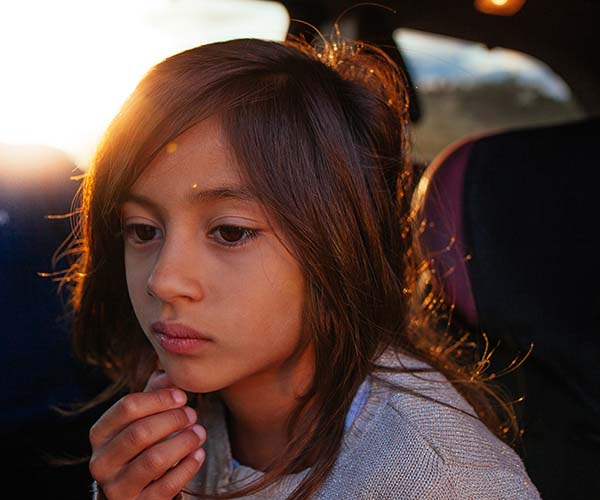
As the parent of an anxious child, you’re most certainly not alone. Millions of families all over the world are right there with you. Though it’s helpful to know yours isn’t the only family supporting an anxious child, it doesn’t make the job of parenting a child struggling with their mental health any easier. What will absolutely help is psychoeducation, a fancy name for learning more about anxiety. The more you know about anxiety and the signs and symptoms to look out for, the easier it will be to recognise what’s happening and how you can help your child to move anxiety out of the way.
Sure childhood comes with ups and downs, and challenges help children to learn, grow and develop resilience. But, anxiety can be more of a challenge for our kids than they’re ready for. That said, it isn’t something that has to stand in the way of them doing the things they love, building awesome friendships and succeeding in school the way you know they can.
Here are some of the ways you can help your child with their anxiety:
1. Model healthy ways of coping
From ‘colourful language’ to finger pointing, to lessons mirrored back at us, kids can sometimes copy us as parents in ways we’d rather they didn’t! Like it or not, our kids watch and model our behaviour which we can use to help them learn how to cope with anxiety, whether it be the normal variety that passes, or the kind that hangs around.
When I’m anxious I’ll often say out loud “I’m feeling anxious right now so I’m going to stop what I’m doing and take 5 deep breaths to calm my system”. Other times I’ll say “I feel myself becoming anxious so I’m going to take some time outside alone for a few minutes”.By hearing how we cope and watching what we do when we’re feeling ‘big’ feelings, our kids learn that they too can manage their feelings when they bubble up
2. Evade avoidance when anxiety shows up
It’s perfectly natural for kids to want to avoid situations, people and scenarios that make them feel anxious or amplify anxiety that’s already a challenge. Avoidance can creep into a child’s life in small ways that can be easily overlooked at first. It’s important to keep the idea of ‘anxiety propelled’ avoidance top of mind so that you can see if for what it is when it happens. Avoiding anything that amps anxiety up brings a lovely relief from anxiety in the short term which reinforces for the child that avoidance feels good. But the next time the same scenario pops up it can make it even more challenging for the child to go along, participate or engage. Over time, avoidance can become the default position – a position from which moving kids can be difficult. With each instance of avoidance, the pattern perpetuates, and the anxiety strengthens. One challenge faced by many parents of anxious kids is refusal to go to school. It starts with a day here and a day there but can become an ongoing challenge for the whole family if not picked up and managed early.
So if you’re to help your child avoid avoidance, what to do instead?
3. Edging an anxious child forward with the stepladder approach
This approach is about helping anxious kids to tolerate their anxious discomfort and take a step in the direction of their goal. That goal could be joining friends at the skate park after school, it could be working with another child on a joint project in class, or it could be spending time away from mum or dad (it’s usually mum) when they’d much rather stay close. Step laddering is also known as exposure and response prevention (ERP).
ERP is one of the most important anxiety management techniques used with children. This is a type of ‘face your fears’ approach but it’s not about throwing kids in the deep end. It’s about breaking down an anxiety-provoking situation into small steps and supporting the anxious child to tolerate their anxiety with each exposure.
There might be anywhere between 10 and 20 steps to move an anxious child towards a particular action. For a child who becomes anxious around dogs, the first step might be to simply write the word dog or look at a picture of a dog. Step by step, over time, the challenges become incrementally greater (and more anxiety provoking) until the ultimate aim is achieved: patting or playing with a friendly dog.
Creating a stepladder plan together with your anxious child is ideal. Start small, very small, and offer lovely social rewards along the way. Things like extra special time together or going to their favourite café for a milkshake are great ideas. You can download a stepladder example and a blank stepladder form here.
4. Support your anxious child to tolerate discomfort
We all like to feel comfortable and our kids are no exception. And because anxiety can feel pretty awful at times, it’s understandable that any relief from those feelings is welcomed. The thing is, the more our children can learn to tolerate discomfort, the less their anxiety is going to stand in the way of them doing all of the wonderful things that life has in store for them.
It’s helpful to think of tolerating discomfort as a ‘muscle’ that gets stronger with training. Each time kids successfully tolerate discomfort they’re reinforcing their ability to do so and cementing the knowledge that they always come out the other side intact. Naming a feeling, and tolerating the uneasiness or distress of that feeling, will help them move through it sooner than they would have had they pushed it aside. When they name it, they help to tame it.
Tolerating discomfort is a willingness to sit with an uncomfortable or emotionally painful feeling. Opportunities for practise are plentiful like when a child is hungry, thirsty, wanting something they can’t have or ending their time watching their favourite YouTuber. Household chores, part-time job interviews, asking someone out on a date or being excluded from a party all bring discomfort. They also create opportunities.
Tolerating discomfort doesn’t mean toughing it out. It’s about teaching your anxious child to notice how they’re feeling, name their emotions, and practice acceptance of how they feel in that moment. All with the knowledge that what they’re experiencing is temporary and that they’re lovingly supported by a warm and comforting parent.
5. Teach your child to know and calm their anxiety
Anxiety is how the brain and body respond in anticipation of a threat. The fight or flight response is initiated and a whole cascade of changes follow. These changes make kids with anxiety feel pretty lousy. Their hearts can race, their breathing becomes faster and shallower, adrenaline flooding the circulation can make hands tremble and insides feel like they’re racing. Stomachs can feel like they’re doing backflips and arms and legs can even begin to tingle. Teach your anxious child that when anxiety shows up it’s because their brain has sensed danger. Their whole body reacts to prepare to fight the danger or run away from the danger fast. They can also worry a lot because that’s another way the brain reacts to keep them safe.
When kids understand anxiety they can see it for what it is. A whole host of changes that, fundamentally, are meant to be protective. All of the changes also give clues as to how to calm anxiety down too.
- Running, skipping, dancing, anything that moves the body helps calm anxiety. Movement is the natural end to the fight or flight response and so it makes sense that exercise of any type will help.
- Deep controlled breathing in and out helps settle anxiety too. This helps kids to show their brain they’re safe and that the fight or flight response is no longer necessary thank you very much!
- Paying attention to exactly what’s happening in the moment also helps to calm an anxious brain. This takes any focus off the ‘threat’ in the environment or from future thinking and helps to calm an anxious response.
- Teach your anxious kid to notice their unhelpful thoughts and give them a new perspective by teaching them that thoughts are not always facts.
6. Teach kids that they can be anxious and do it anyway
One of the hardest parts about having anxiety is that the symptoms can really get in the way of kids doing everything they want to do – and need to do. Missing out isn’t fun, and whether it’s a party or school, joining in in the classroom or going on camp, avoidance leaves kids feeling on the outer and only makes going or participating the next time so much harder.
What if you could teach your anxious child or teen that they can feel anxious, they can feel uncomfortable, and they can actually still put one foot in front of the other to do the thing? Go to the party, go to school, present their project in front of their class, take a lesson or two in watercolour to advance their artistic skills, enjoy a sleepover, go to camp, submit their story to that competition, have a friend over after school or even, put their hand up to answer a question. Whatever it is that your anxious child would love to do in a ‘perfect world’ doesn’t have to wait. They can be anxious and do it anyway. This is where step laddering helps too, remember; we don’t want to ask too much of them too soon but we also don’t want to support refusal and avoidance. In the end, it serves only to make anxiety bigger and life smaller.
The wonderful thing to know about anxiety is that it is a treatable condition. If you’re concerned about your child’s mental health jump on the phone and make an appointment to chat to your child’s GP. For additional support as your child’s co-anxiety coach, the best-selling book Anxious Kids supports you to do everything I’ve included here and so much more. You can get your copy here.

share the love
[Sassy_Social_Share]

about
Jodi is on a mission to elevate mental health and wellbeing in families, classrooms and workplaces.


free 5-day
Calm your anxious brain
mini course

Recent Posts

free 5-day
Calm your anxious brain
mini course
Sign up for my free 5-day ‘Calm Your Anxious Brain’ email mini-course. Put the strategies into place for yourself, light the way for your kids, or do both.






